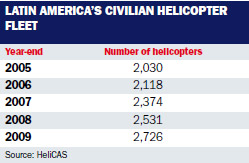Russia's UTair is planning expansion throughout Latin America, which has remained one of the world's fastest-growing civilian rotorcraft markets despite the global economic downturn, following its acquisition of Peru's largest helicopter operator.
UTair purchased Peruvian sister companies AviaSur and HeliSur in a transaction that closed last year. The deal gave UTair, which operates a fleet of about 200 mainly Russian helicopters and is the launch customer for the new Eurocopter EC175, its first footprint in the fast-growing Latin American market.
HeliSur/AviaSur vice-president Mamed Kasumov says UTair Group's new Lima-based subsidiary is operating a fleet of 13 Mil Mi-8 MTV and Mi-171 helicopters under the HeliSur brand, with more than 250 employees. He reveals UTair plans to add Mil Mi-26 super heavy and EC175 medium twin helicopters to its Peruvian-registered fleet as part of an expansion plan that also envisages operations in other South American countries.
"The prospective is to make the Peruvian company the base for expansion in the Latin American market," Kasumov says. "We are looking now at Ecuador, Chile and Brazil."
He says the first phase of the expansion will involve the delivery of two or three additional Mi-8/171s in 2010 to meet growing demand from HeliSur's customer base. HeliSur now operates on-shore missions "for oil and gas exploration companies working in Peru" including Petrobas and other leading energy companies with aviation departments that "have their own system of certification and have the highest safety standards".
UTair also sees an emerging requirement in Peru for offshore oil missions, a type of operation that the new EC175 is being developed to meet. UTair, which is now the world's fourth-largest helicopter services provider with operations in six continents, has 15 EC175s on order plus 15 options for delivery from 2012. Kasumov says some of these helicopters will be operated by HeliSur, but the number of EC175s that will end up in Latin America depends on the outcome of contract negotiations with potential customers.
POTENTIAL
While the oil and gas sector has fuelled HeliSur's expansion since it was established in the early 1980s, UTair sees potential in other sectors. Kasumov says shifting some of UTair's 24 Mi-26s - which are capable of carrying 20t of cargo on a sling or inside - to Peru will in particular open new business opportunities for HeliSur.
"We expect them to be used in pipeline construction or in multinational electricity line construction," Kasumov says. "Oil and gas is only one field of activity. We can perform firefighting. We can perform construction work. We can provide heavy cargo delivery. We know there are opportunities."
Kasumov says another integral component of UTair's South American expansion plan is to become the leading third-party maintenance provider for the growing base of Mil helicopters operating in the region.
UTair already offers third-party maintenance at several of its other facilities and is now expanding HeliSur's Mil-authorised maintenance facility at Lima's Jorge Chavez International airport. "Our ambition is to make the investment, expand and develop the centre and to establish the largest and most professional centre of Mil design helicopters," Kasamov says.
Kasamov, who is also director of UTair's New York-based US division, says the group first looked at acquiring AviaSur and HeliSur in 2008. It was attracted to the Peruvian companies because they controlled two-thirds of "the Peruvian helicopter operations market".
UTair looked at other South American markets, but Kasamov says Peru offered the best option, given its central location on the continent and the fact it had a growing local market that is not as crowded as Brazil. Kasamov sees potential for UTair in Brazil, particularly for the Mi-26 as the giant helicopter is not currently being operated anywhere in Latin America, but believes smaller South American markets such as Ecuador, where there is less competition, could present better business opportunities.
He says UTair concluded the Latin American market offers significant potential "even in terms of the decline of the world economy". While UTair began its international expansion in the early 1990s, initially through work for the United Nations, Latin America represented the last frontier for the large Russian company.
UTair is by no means alone in seeing tremendous opportunity for helicopters in Peru and Latin America overall. Rival US-based heavy lift specialist Columbia Helicopters also has established a Peruvian company, which it says now operates two of its Boeing 234 Chinooks with a third likely to be delivered later this year.
Like Heli-Sur, Columbia is operating its Peru-based helicopters on high utilisation onshore contracts for oil and gas companies. Columbia, which previously operated logging missions in Chile, says it is also looking at opportunities in the Ecuadorean, Colombian and Brazilian markets.
The FIDAE 2010 air show will also mark the Latin American debut of the Bell 429. Bell chief executive John Garrison, who will accompany the new light twin helicopter on its first tour of the region, says the 429 is particularly well positioned to meet growing demand for corporate transport in the region's major cities, including Mexico City, São Paulo and Santiago. He says the oil and gas sector in the region is also "strong".
As of the end of 2009, there were 2,726 civilian helicopters operating in Latin America, including 1,809 in South America and 917 in Central America, Flightglobal HeliCAS data reveals. This represents 47% growth compared with the 2,030 helicopters operating four years ago (see chart). But Russian models now only account for 2% of the total market.

SIGNIFICANT INCREASE
Russian Helicopters sales director Mikhail Dubrovin says that "we're quite sure we'll increase this fleet significantly", and he singles out Brazil and Peru as offering the most potential. To bolster sales efforts and improve support of existing helicopters in the region, Russian Helicopters, which was formed in 2006 to manage the consolidated Russian rotor-wing industry, is now leading a major expansion of the industry's Latin American service footprint.
Dubrovin says authorised civilian service centres will soon be opened in Colombia and Mexico, joining the existing centre in Peru.
Source: Flight International
















